|
The Inaugural SBC* |

|
By Samuel W. Norwood III -
Atlanta, Georgia - USA
photos by Beth Tumlin and Alice Lynch |
*Classic Boat Rally - Savannah,
Beaufort, Charleston
The First
SBC Classic Boat Rally, from Savannah,
through Beaufort, to Charleston, was completed Wednesday,
May 3. Six boats participated. They were, two Herreshoff
12 ½ s (16 feet LOA), two Marshall Catboats
(an 18 and a 22), a Cape Dory Typhoon (19 feet LOA),
and a Melonseed Skiff (13 ½ feet LOA). This
was the beginning of what seems sure to be a growing
event in the southeast in years to come.
The sailing was up the Intracoastal Waterway (ICW)
in these classic designs. The total journey took six
days including a “lay day” in Beaufort,
Sunday, April 30, for rest and an around-the-buoys
race. Each leg of the adventure was twenty to thirty
nautical miles, although some days were longer due
to adverse winds that caused tacking to windward.
The longest day was the final one, turning out to
be thirty-six nautical miles sailed in 7 ½
hours. The timing of the rally was set to take maximum
advantage of the tides. Tides in this area run seven
to eight feet, causing currents of two to four knots.
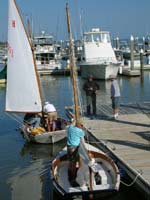 |
The classics
were allowed to launch and begin this
adventure at Savannah Yacht Club on the
Wilmington River just west and a bit south
of the historic city of Savannah.
(click
images to enlarge) |
|
Through the kindness of Olin McIntosh, the classics
were allowed to launch and begin this adventure at
Savannah Yacht Club on the Wilmington River just west
and a bit south of the historic city of Savannah.
SYC is one of the oldest yacht clubs in the United
States and was host of the Olympics when they were
in the USA in 1996. Catching the last of the incoming
tide, the boats sailed up the Wilmington, under Thunderbolt
Bridge, and past the renowned Bonaventure Cemetery
made famous by the book and movie, “Midnight
in the Garden of Good and Evil”. The cemetery
was reached at high tide. The tide breaks at the cemetery,
so the boats sailed on to the Savannah River with
the outflowing tide and across to “Fields Cut”.
At Fields Cut, the wind died. Malcolm Peter’s
H-12 ½ had a malfunction in the rigging, so
they anchored to fix the problem. It turned out that
this was the best thing to do in the presence of a
dying wind and an adverse tide. On occasional zephyrs
of wind, Woody Norwood’s H-12 ½ would
approach Malcolm’s anchored position and then
fall back with the tide. With repairs made, Malcolm
and Woody decided to crank up the motors to get through
this cut which led to Wright River briefly and Walls
Cut that leads to Ramshorn Creek.
| In air this
light we use the motor until the breeze
returns |
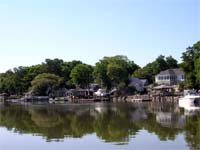
|
|
Finally the wind returned and we were sailing again.
Most of these “cuts” were created in World
War II to connect the rivers and creeks along the
coast so that barge traffic could move commodities
up and down the coast without having to venture into
the Atlantic where Nazi U-boats made for hazardous
conditions. Ramshorn Creek goes up the west side of
Daufuskie Island which is now developing rapidly as
a resort community. Pat Conroy’s book, The Water
is Wide, was about this island where Mr. Conroy (the
movie was “Conrack”) was a teacher of
the local Gullah children who had never been off the
island. Ramshorn Creek leads into the Cooper River.
We sailed down the Cooper River with the ebbing tide
as it emptied into Calabogue Sound. We crossed the
Sound into a head wind and made it to Harbour Town,
an upscale marina on Hilton Head Island. There, we
tied up the boats and had a cold beer before heading
by car back to Savannah to retrieve the trailers and
then to Beaufort to spend the night.
| Frank Pontious
and Woody Norwood reaching with the spinnaker
on H-12 "Myrdie" |
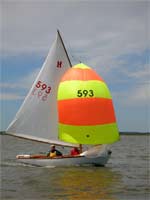
|
|
The Saturday forecast was for winds of 15 to 30 MPH
offshore, and 25 MPH along the ICW. This was going
to be a day of challenging weather caused by a cold
front. In this region, a cold front means wind from
the northwest to northeast for several days. As our
fundamental course on the ICW is generally from the
southwest to the north east, the cold front was bad
news because it would mean adverse (on the nose) winds
for the rest of our journey.
Jonathan Clarke, a Navy physician who had recently
returned from seven months in Iraq, had taken delivery
of a brand new Melonseed Skiff, a 13 ½ foot
sprit-rigged sailboat from a nineteenth century design,
trailered his boat to Hilton Head with hopes of sailing
with the fleet to Beaufort. It was not to be. The
wind was a steady 20 MPH in the morning out of the
northeast, and the waves in Calabogue Sound were two
to three feet high. The Melonseed was not able to
handle the conditions and so Jonathan quickly came
into port and called it a day.
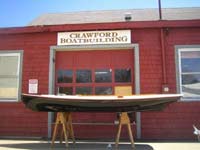 |
Jonathan
Clarke's Melonseed Skiff, "Spartina",
before being shipped from the builder.
These are beautiful boats but, we found
out, not quite up to the challenges of
the SBC full course. |
|
The two H-12s came out of Harbour Town and beat their
way northward along the Hilton Head west coast on
Calabogue Sound, but it was very wet going. At the
north end of Hilton Head, these two boats, about an
hour ahead of their schedule, pulled into Skull Creek
Marina to get warm, eat a sandwich, and to reef the
mainsails before crossing Port Royal Sound. At 1 PM
the H-12s departed Skull Creek Marina for the crossing
of Port Royal Sound.
Port Royal Sound is potentially the most treacherous
part of the journey from Savannah to Charleston. The
Sound is wide open to the Atlantic from the east to
the south. This is a large body of water, and the
waves get particularly “peaky” when the
tidal current is running in the direction opposite
the source of the wind. As we crossed, basically from
west to east, the tide was running toward the southeast
and the wind was coming from the east/northeast. The
choppy waves were three to four feet high, and the
wind was a steady 25 MPH. For the H-12s it was a beat
to windward. With the mainsail reefed, Malcolm Peters
and team mate Frank Pontious, Commodore of Beaufort
Yacht and Sailing Club, initially took a port tack
to the south, while Woody Norwood and team mate Bill
Tumlin took an initial starboard tack out into the
Sound. As the wind clocked more eastward, the Peters/Pontious
team tack to starboard and beat the Norwood/Tumlin
team to the south tip of Parris Island (the Marine
basic training place) and into the Beaufort River.
Once both teams made it to the River it was a wonderful
starboard tack reach all the way to the town of Beaufort.
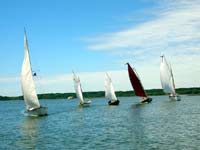 |
The picture
at left, taken by Beth Tumlin, shows the
five boats other than Jonathan Clarke’s
Melonseed Skiff that sailed in the rally. |
|
It had been planned that a Marshall catboat 22, owned
by Roy Crocker, a retired paper executive, and a Marshall
Catboat 18, owned by Andy Corriveau, an insurance
broker, and a Cape Dory Typhoon (about 19 feet LOA),
owned by Jerry Wadley, a retired radiation ecologist
and current publisher, would rendezvous with the H-12s
out on Port Royal Sound. The rendezvous did not happen.
These boats came down to the Sound, bounced around
for a while on the Beaufort side of the Sound, and
then returned to Beaufort ahead of the H-12s. Everyone
was in port by 5 PM.
| This Marshall
18 belongs to Andy Corriveau (left) who
was sailing with his grandson, 12-year-old,
Drew (right). The writer, Coty Miranda,
on assignment from Sail Magazine, sailed
with Andy and Drew. |
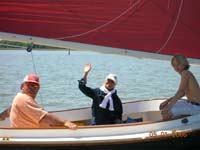
|
|
All participants gathered from 6 to 8 PM at Beaufort’s
Carriage Court town-home development for cocktails
and heavy hors d’oeuvres provided by the residents
in honor of the sailors.
Sunday was a “lay day” for the sailors.
The Beaufort yacht and Sailing Club (BYSC) declared
this to be “Classic Boat Day” in honor
of the fleet. A race around the buoys was scheduled
for 2 PM. As the starting gun sounded, the fleet was
drifting down tide in virtually windless conditions.
When an hour had passed and no one had even made it
to the starting line, the fleet cranked up their engines
and returned to the BYSC dock.
Monday was a beautiful day for sailing with the wind
from the northeast at around 10 MPH all day. Bill
and Beth Tumlin, from Atlanta, generously served as
race committee general support boat, and unofficial
photographers. George Dewhirst, US Navy Captain (ret.)
and former submarine commander, signed on as Malcolm
Peters’ team mate for three days starting on
Monday. The fleet had an initial six-mile race from
BYSC, past the historic downtown Beaufort, to “the
Brickyards” up the Beaufort River. Andy Corriveau,
sailing with his 12-year old grandson, “Drew”,
in the Marshall 18, beat the second finishers, the
Woody Norwood / Frank Pontious team in an H-12, by
12 minutes, but it was estimated that half the time
advantage was gained when Corriveau, a long-time sailor
in Beaufort, took a risky short-cut through the marshes.
After the finish, the boats gathered for a photo shoot
that just might make the cover of the August issue
of Sail magazine. John Snyder, a writer/photographer
resident of Maine, was sent by Sail to be the official
photographer of this event. “Sail” also
engaged Coty D. Miranda, a free-lance writer currently
a resident of Phoenix, to write the story, and she
sailed on Roy Crocker’s Marshall 22 on Monday.
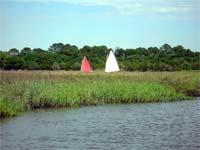 |
Marshall
Catboats in the marsh
|
|
We soon started a second race, a seven-mile sprint
down the Coosaw River to the Ashepoo Cut. Andy and
Drew won this race also, but the total time between
first and last place was only 8 minutes.
The Ashepoo Cut leads to the Ashepoo River and thence,
through Fenwick Cut, to the South Edisto River. Once
in the South Edisto River, the fleet departed from
the ICW and sailed down the South Edisto with the
ebbing tide to Edisto Marina. At the Edisto Marina
the participants’ shore crews (spouses) arrived
by car and the whole group enjoyed dinner at the Sundeck
Restaurant overlooking the marina as the sun descended
over the marshes to the west. After dinner, everyone
except the Crockers (Roy and Carol) returned to Beaufort
to spend the night. The Crockers spent the night on
their boat. The next day the Crockers sailed back
to Beaufort, and Jerry Wadley pulled his Cape Dory
Typhoon out onto a trailer using the marina ramp.
Jerry had client commitments that forced his withdrawal.
| Malcolm Peters
and George Dewhirst at Edisto Marina pose
before departure to Bohicket |

|
|
On Tuesday, the two H-12s and the Marshall 18 sailed
(and motored) to Bohicket Marina on Seabrook Island.
This was a day with only occasional zephyrs of wind
to punctuate the otherwise glassy conditions. We sailed
with the zephyrs and motored in the doldrums until
the sea breeze piped up as we entered the North Edisto
River. This produced a refreshing beat to windward
as a two-hour finale for the day, and we arrived at
Bohicket just before 5 PM. Malcolm showed particularly
good judgment regarding when to crank up the engine.
This night the H-12 teams went to Charleston for dinner
at Cypress restaurant on East Bay Street, a wonderful
dining experience, and then retired for the night
at the Rutledge House Inn on Broad Street. The Rutledge
House was built in the 1780s by John Rutledge, on
of the signers of the Constitution, and is a highly
recommended Bed and Breakfast in the historic section
of Charleston.
Wednesday was probably the best sailing day of this
journey. The wind was 10 to 20 MPH from the northwest
and west all day. From Bohicket Marina to the north
end of Edisto Island, about 2 ½ hours’
sailing, the wind was on the nose and very wet conditions
as the incoming tide was opposite the direction of
the wind. In these conditions, the H-12s demonstrated
superior speed to windward compared to the Marshall
18. Again, Malcolm showed good judgment in reefing
the mainsail of his H-12 as the boats were sailing
at hull speed, and the unreefed main did not add to
speed, only to the loads on the rig. Once we turned
east, however, it was a port tack reach and run the
rest of the way to Charleston, and the Marshall 18
trotted away from the H-12s. When the wind settled
down to about 12 MPH, the team of Woody Norwood and
his cousin, Joe Norwood, hoisted the spinnaker and
had about an hours’ run flying in the H-12 “Myrdie”
to Elliott Cut (known to the locals as Wapoo Cut as
it leads into Wapoo Creek). Here the tidal current
can run 3 to 4 knots. Fortunately the tide was with
us, ebbing toward the Ashley River which comes down
the east side of the Charleston peninsula.
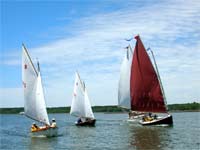 |
The Herreshoffs
and the Marshalls on the Beaufort River
|
|
Charleston Harbor can be choppy at times, but this
particular Wednesday the harbor was perfectly gorgeous
with a 10 MPH wind and full sunshine. We sailed around
the “Battery” at the southern tip of Charleston,
in full view of Fort Sumter where the Civil War began,
and in front of the magnificent homes along East Bay
Street. Rounding up against the ebbing current of
the Cooper River, we dropped our sails and motored
into the harbor of Carolina Yacht Club, concluding
our journey from Savannah.
As we tidied up the boats there I had mixed emotions
of elation for having had this wonderful adventure
and yet sadness that it was now at an end until next
year.
| Carolina Yacht
Club Harbor: Final destination |
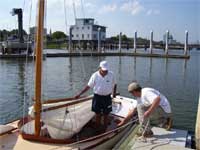
|
|
Through our friend and sponsor at Carolina Yacht
Club, Guy Mossman, we were able to have our victory
celebration dinner at the club. Sixteen of us hoisted
our glasses to toast what we all believe could become
an annual event for small classic boats, tying together
three fine clubs of sailing enthusiasts who have a
particular appreciation for designs of the late nineteenth
and early twentieth centuries.
The enthusiasm of this group who participated in
this, the inaugural SBC Classic Boat Rally, shows
the power of a good idea. We shared the challenges
of wind, water, tidal currents and navigation. We
also shared the joy of adventure and a full day in
boats, and with people, that we care about.
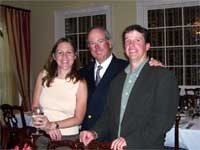 |
The victory
celebration was held in the Magnolia Room
at Carolina Yacht Club. All dressed up,
we hardly recognized each other. This
is the author and Joe Norwood with Joe's
fiancee, Rhonda
|
|
In particular, there are two people in this experience
that became “captains” of the ship in
the course of the journey. One of these is Malcolm
Peters who, with little sailing experience, bought
an H-12 because he had a dream of sailing it on adventures
like this with his wife, Bonnie. After buying the
boat, Malcolm and Bonnie took sailing lessons from
Joe Jurksis (Blackbeard) on the Georgia coast, but
this was just enough of an experience to give Malcolm
an appreciation of the complexities of coastal sailing.
His boat had not been in the water since his lessons
on the Georgia coast. He was able to get matched with
three very experienced sailors as his team mates (Bill
Tumlin from Atlanta, Frank Pontious from Beaufort,
and George Dewhirst, now retired in Beaufort) and
Malcolm gained the experience that will enable him
and Bonnie to sail safely anywhere and H-12 can go.
The other is Andy Corriveau’s grandson, Drew.
Drew has a natural feel for boat handling, and, at
age 12, was skipper much of the time in Andy’s
Marshall 18. Drew already has a vision of going to
the Naval Academy for college and ultimately becoming
a naval architect. I think he has a good shot at achieving
both dreams. I think the SBC Classic Boat Rally will
be a great memory for your Drew. I know that it will
be for his grandfather, Andy, not just for the sailing
but, more importantly, for the relationship that builds
when a grandparent and grandchild can share this kind
of experience together.
Samuel W. (“Woody”) Norwood III
May 8, 2006
404-352-9536

|